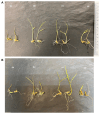Bio-efficacy of Nanosilicon in Regulating Oxidative Activity to Control Rice Seedlings Rot Disease Caused by Burkholderia glumae
- PMID: 40211620
- PMCID: PMC11986358
- DOI: 10.5423/PPJ.OA.08.2024.0123
Bio-efficacy of Nanosilicon in Regulating Oxidative Activity to Control Rice Seedlings Rot Disease Caused by Burkholderia glumae
Abstract
Bacterial panicle blight and seedling rot diseases in rice plants (Oryza sativa L.) are caused by the pathogenic bacterial Burkholderia glumae. The nanosilicon treatment is gaining attraction but its effectiveness towards B. glumae infection in rice seedlings through regulating enzymatic activities remains largely unexplored. This study aimed to evaluate the bio-efficacy of nanosilicon in controlling seedling rot disease through regulation of peroxidase and polyphenol oxidase enzymes after challenge infected with B. glumae in rice variety MR297 and PadiU Putra. Nanosilicon was applied as seed priming in germination testing at 0, 300, 600, and 900 ppm on both rice varieties before B. glumae inoculation. Both rice seed varieties primed with nanosilicon at 600 ppm exhibited a significant increase in seedling germination performances over control. The rice seedling of MR297 was more responsive to nanosilicon at 600 ppm with only 17.78% of disease severity index over 26.67% in PadiU Putra and was therefore selected for the enzymatic activity screening. The results showed that the foliar spray of nanosilicon rice plants (MR297) significantly increased both peroxidase (POX) at 24 h and polyphenol oxidase (PPO) at 48 h after B. glumae inoculation with 20.44/min/g and 7.46/g activities, respectively. In addition, the plant growth performances were significantly increased compared with control under the same treatment. This demonstrates nanosilicon's potential to control rice seedling rot disease by regulating POX and PPO activities and hence promote plant growth. The application of nanosilicon is an environmentally friendly approach for controlling B. glumae infection at the early rice growing stage.
Keywords: Burkholderia glumae; enzymatic activity; nanosilicon.
Conflict of interest statement
No potential conflict of interest relevant to this article was reported.
Figures




Similar articles
-
Nano formulation development and antibacterial activity of cinnamon bark extract-chitosan composites against Burkholderia Glumae the causative agent of Bacterial Panicle Blight in rice.PLoS One. 2025 Jun 20;20(6):e0320032. doi: 10.1371/journal.pone.0320032. eCollection 2025. PLoS One. 2025. PMID: 40540526 Free PMC article.
-
First complete genome sequence of a Bacterial Panicle Blight causing pathogen, Burkholderia glumae, isolated from symptomatic rice grains from Bangladesh.BMC Genom Data. 2024 Jul 29;25(1):73. doi: 10.1186/s12863-024-01255-5. BMC Genom Data. 2024. PMID: 39075351 Free PMC article.
-
Selegiline for Alzheimer's disease.Cochrane Database Syst Rev. 2003;(1):CD000442. doi: 10.1002/14651858.CD000442. Cochrane Database Syst Rev. 2003. PMID: 12535396
-
Systemic pharmacological treatments for chronic plaque psoriasis: a network meta-analysis.Cochrane Database Syst Rev. 2021 Apr 19;4(4):CD011535. doi: 10.1002/14651858.CD011535.pub4. Cochrane Database Syst Rev. 2021. Update in: Cochrane Database Syst Rev. 2022 May 23;5:CD011535. doi: 10.1002/14651858.CD011535.pub5. PMID: 33871055 Free PMC article. Updated.
-
Adefovir dipivoxil and pegylated interferon alfa-2a for the treatment of chronic hepatitis B: a systematic review and economic evaluation.Health Technol Assess. 2006 Aug;10(28):iii-iv, xi-xiv, 1-183. doi: 10.3310/hta10280. Health Technol Assess. 2006. PMID: 16904047
References
-
- Abdallah Y., Nehela Y., Ogunyemi S. O., Ijaz M., Ahmed T., Elashmony R., Alkhalifah D. H. M., Hozzein W. N., Xu L., Yan C., Chen J., Li B. Bio-functionalized nickel-silica nanoparticles suppress bacterial leaf blight disease in rice (Oryza sativa L.) Front. Plant Sci. 2023;14:1216782. - PMC - PubMed
-
- Alexandratos N., Bruinsma J. World Agriculture towards 2030/2050: the 2012 revision. ESA Working Paper No. 12-03. Food and Agriculture Organization of the United Nations; Rome, Italy: 2012. p. 147.
-
- Aqaei P., Weisany W., Diyanat M., Razmi J., Struik P. C. Response of maize (Zea mays L.) to potassium nano-silica application under drought stress. J. Plant Nutr. 2020;43:1205–1216.
-
- Asgari F., Majd A., Janoubi P., Najafi F. Effects of silicon nanoparticles on molecular, chemical, structural and ultrastructural characteristics of oat (Avena sativa L.) Plant Physiol. Biochem. 2018;127:152–160. - PubMed
-
- Badawy S. A., Zayed B. A., Bassiouni S. M. A., Mahdi A. H. A., Majrashi A., Ali E. F., Seleiman M. F. Influence of nano silicon and nano selenium on root characters, growth, ion selectivity, yield, and yield components of rice (Oryza sativa L.) under salinity conditions. Plants. 2021;10:1657. - PMC - PubMed
Grants and funding
LinkOut - more resources
Full Text Sources

